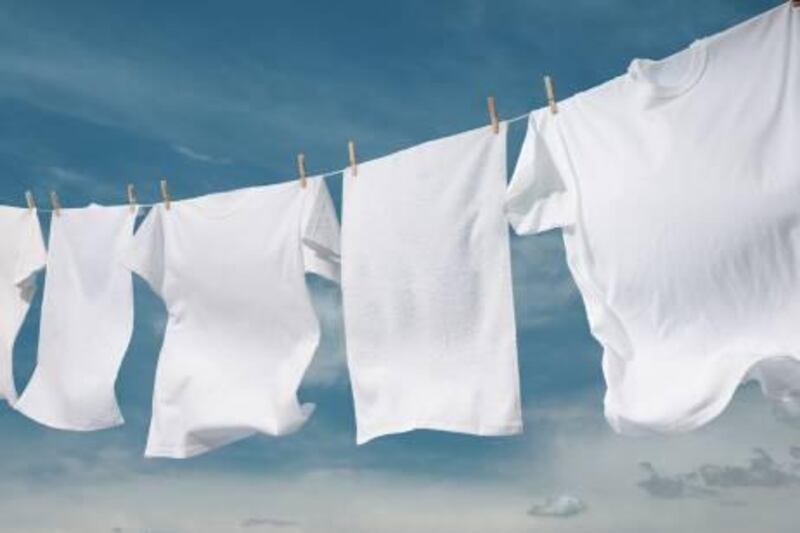Everybody, it seems, is telling us to wash our laundry at lower temperatures. Turning our dials down to 30°C can reduce the precious energy used by our washing machines by 41 per cent.
"The vast majority of households wash laundry at 40°C or above. Turning to 30°C is a really simple and effective way to use less energy and reduce your environmental impact on a regular basis," Joanna Yarrow, the founder of the sustainability company Beyond Green, was recently quoted in a press release from the detergent brand Ariel as saying. "It takes no extra effort yet the benefits are huge."
Leading laundry detergent brands advertise new gel products that deliver "brilliant cleaning results at temperatures as low as 15°C", while washing machine manufacturers are advising consumers to turn their dials down and are racing to introduce special "eco" cycles because low temperature programmes have become key selling features. It is almost universally accepted that washing at lower temperatures saves money, energy and time. But does it really?
A recent study has highlighted serious hygiene risks associated with low-temperature washing that can't be ignored. Professor Sally Bloomfield of the London School of Hygiene and Tropical Medicine and the author of the report, says there is a real risk that laundry could transmit infectious diseases when items are washed at low temperatures with detergents that are not bleach-based.
"Our parents and grandparents always used powder or tablets that contained oxygen-based bleach to kill bacteria as well as clean clothes," she explains. "But nowadays, lots of people prefer liquid detergents, which contain enzymes to lift dirt from fabrics. The problem is, they don't kill the bacteria. Clothes may look and smell clean, but they won't necessarily be hygienically clean.
"What's more, we're washing at lower temperatures in order to save money and the environment. I'm concerned that these cooler washing cycles aren't killing bacteria."
It is worrying to learn that bacteria such as methicillin-resistant Staphylococcus aureus (MRSA) can survive cooler washes, which could potentially mean that certain resistant strains might thrive in the community. "If a member of your family is carrying MRSA, uses a towel, then somebody else uses the towel it can spread. It really is as easy as that," Bloomfield says. "The more MRSA is passed around, the more likely it is to get into hospitals and infect patients who have cuts or abrasions. It's a real risk, and one of the reasons why hygienic laundry practice is so important.
"Just like door handles, tap handles, our hands, food contact surfaces and so on - dirty laundry can be a critical point in the transmission of infection. Proper laundering at the correct temperatures with the right detergents should be an everyday part of our hygiene regimen, just like washing your hands or disinfecting food preparation surfaces is."
Luckily, there are some simple things we can all do to make sure our laundry is hygienic and to minimise the risk of spreading infection:
• Don't share towels - allocate one for each member of the family.
• Wash your hands thoroughly with hot water and soap after handling dirty laundry.
• Never put wet items in your laundry basket.
• Don't mix soiled underwear, towels or bed linen with low-risk outer clothing in the laundry basket or a wash.
• Launder kitchen tea towels and dish cloths separately.
• Dry laundry as soon as possible after washing. Leaving it damp in the machine overnight can cause germs to multiply rapidly.
• Tumble drying at high temperatures helps to keep laundry hygienic.
• Always use bleach-based detergents if you're using a shared launderette.
• Keep your washing machine clean. It's not just our health that could suffer if we wash at low temperatures regularly. Cooler temperatures and liquid detergents encourage slime and scum to build up inside your machine, which could cause technical problems as well as make your laundry dirty.
Joseph Oram, the product manager for laundry at Samsung, advises flushing out your washing machine on a regular basis: "Run a very hot (ideally 70°C) wash programme to sanitise the drum and interior of your washing machine and keep it in peak condition," he says.
It's also important to keep the detergent drawer, door seal and rubber lining clean. Use a disinfectant spray and clean cloth to wipe it every week to kill bacteria inside it.
For more information and advice, visit the International Scientific Forum on Home Hygiene, www.ifh-homehygiene.org, and the Energy Saving Trust, www.energysavingtrust.org
Temperature guidelines
Confused about what temperature to use? The International Scientific Forum on Home Hygiene recommends these guidelines for best laundry hygiene
30°C-40°C
Underwear, socks, bedding, sheets, bath towels. Everything that comes into contact with your body regularly should be washed at 30°C-40°C with a traditional bleach-based detergent powder or tablet.
40°C or less
Outer clothing. You can wash clothing that doesn't come into direct contact with your body such as skirts, jackets and trousers at lower temperatures and use laundry liquids that don't contain oxygen-releasing bleach. It won't constitute a serious infection risk.
60°C or more
Kitchen cloths and towels, sports clothing, heavily soiled items (such as reusable nappies), health care workers' uniforms or anything that presents a high-risk situation. "If somebody in your home has an infection or is particularly vulnerable to infection, all underwear, clothing, towels and bed linen should be washed at 60°C or more using a bleach-based laundry detergent powder or tablet," says Professor Sally Bloomfield of the London School of Hygiene and Tropical Medicine.





